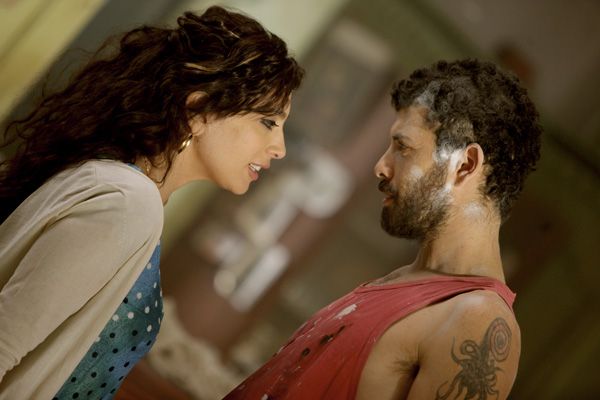
Nadine Labaki and Julien Farhat in WHERE DO WE GO NOW? (Rudy Bou Chebel/Sony Pictures Classics)
Where Do We Go Now? is about as feel-good a fable set in the Middle East as can be imagined. Infused with music and magic realism, a female narrator introduces it with “I’m going to tell you a little story” as a large procession of women in black sway and stomp like an active Greek chorus, reflecting the Aristophanes’ Lysistrata-like resonance in the tale. When they reach the village cemetery, they split into the Christian and Muslim sections to clean up gravestones with photographs of too many young men and boys. This locale is similar to the unspecified, yet Lebanon-like war-torn country of Denis Villeneuve’s far more grim Incendies from last year.
Back in the village, bounded by a mosque and a church, the men are hanging around the tavern. The only guy working hard there is the handsome Muslim painter, Rabih (Julien Farhat). The most beautiful Christian woman in town, the waitress Amale (director and co-writer Nadine Labaki), can’t help but notice him. Both bound by tradition, they can only be discreetly romantic in a lovely musical number dancing together, but only in their imaginations. (The terrific rhythmic music is by Labaki’s husband, Khaled Mouzanar.)
The village boys scamper around, setting up satellite TV that links the village to the outside world. They also smuggle goods along a precipitous path to avoid the hidden land mines that wandering goats occasionally set off. This limited contact is enough to bring in hints that the civil war has once again broken out, and the women spontaneously decide that the key in keeping their male population safe is to block out news of the renewed fighting. From first burning newspapers to blocking channels, their efforts humorously escalate to emphasize the men’s foibles, including hiring imported sexy Russian dancers as a distraction.
As the outside dangers are brought home by injuries to the daring boys, the dancers see that the photographs on the graves are the same ones that fill shrines in each home, and, in female solidarity, they help the women stage the ultimate strike against religious differences to prove that people really are the same. Female-centric like Labaki’s first film Caramel (2007), it’s as rich in sympathetic, individual characters, but funnier, albeit a bit over the top and satirically absurd, (there’s a fake religious miracle). Labaki demonstrates that there is hope to look beyond endless conflict, even if it is wishful thinking about an uncertain future.






Leave A Comment